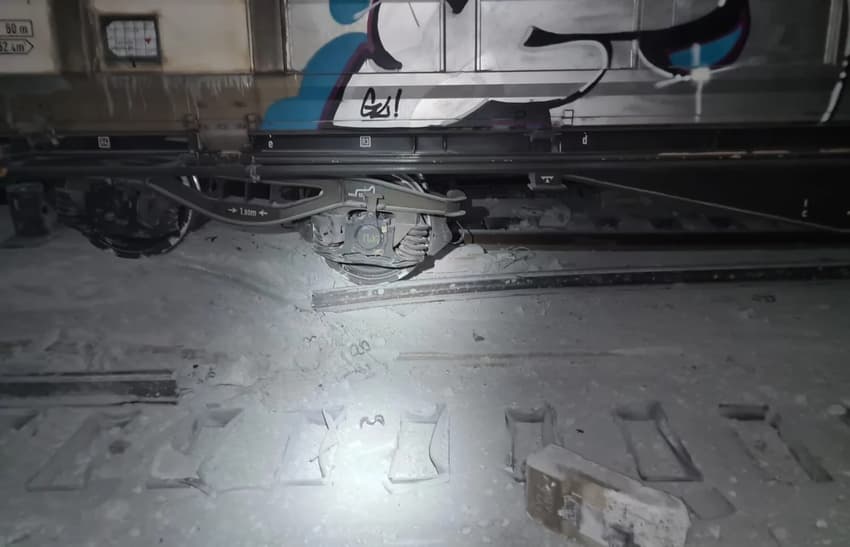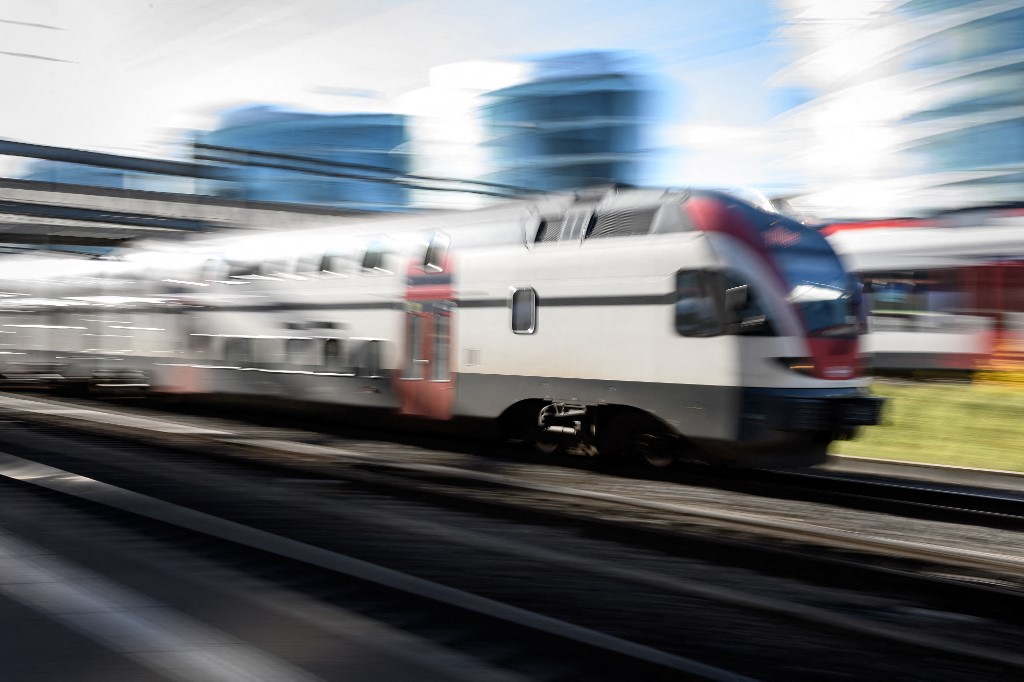How train travel in Switzerland will be hit by months-long Gotthard tunnel closure

Swiss authorities have confirmed that the Gotthard base tunnel will be closed for months to passenger rail services due to damage. International services in particular will be affected.
What's happening?
A goods train travelling from Italy to Germany came off the track inside the Gotthard base tunnel around lunchtime on Thursday August 10th resulting in severe rail traffic disruption. Nobody was injured in the accident.
Now rail operator SBB says that the repairs are more difficult than expected - and the tunnel will now likely not open to passenger trains until early 2024.
The tunnel connects German-speaking Switzerland with the Italian-speaking canton of Ticino and is part of a north-south axis from Germany to Italy. That makes it a key route for international travel, as well as for transporting goods by train.
The tunnel is the world's longest and deepest rail tunnel. It opened in June 2016 and full service began later that year.
SBB CEO Vincent Ducrot said: "The Gotthard base tunnel is one of the safest in the world. The fact that such an accident could happen is very upsetting to us. Fortunately, there were no injuries, but there was a lot of damage."
READ ALSO: Disruption to rail travel in Switzerland after goods train derails
What does this mean?
Essentially it means that certain passenger rail services will be disrupted until at least 2024.
After the incident happened, Intercity and Eurocity trains running between German-speaking parts of Switzerland and Ticino as well as northern Italy, were diverted via the Gotthard panorama route.
This diversion will remain in place.
However, it does mean that journeys take a longer amount of time.
The travel time is extended by 60 minutes for national traffic and by between an hour to two hours for international traffic.
 A train of the Swiss Federal Railways (SBB / CFF / FFS) moves along tracks in Geneva in 2019. Train travel is affected by the Gotthard base tunnel closure. (Photo by Fabrice COFFRINI / AFP)
A train of the Swiss Federal Railways (SBB / CFF / FFS) moves along tracks in Geneva in 2019. Train travel is affected by the Gotthard base tunnel closure. (Photo by Fabrice COFFRINI / AFP)
International passengers have to change trains in Chiasso. Only trains to and from Genoa and Venice will run directly, SBB said.
Adding to the problem is that double-decker trains can't run on the panorama line, while extra trains can't be added at peak times.
"The single-deck trains have less capacity than the double-deck trains," SBB said. "At weekends, there are up to 30 percent fewer seats available until further notice." On weekdays, capacity is slightly reduced.
Rail operators said they are investigating whether the seating capacity can be increased via the Gotthard panorama route and whether additional direct international connections can be offered.
Ducrot added that SBB was aware that the effects of the incident have caused major inconvenience for passengers and freight customers.
"We would like to apologise for this and ask for your understanding," he said. "The teams deployed are doing their utmost to ensure that safe rail traffic through the Gotthard base tunnel is possible again as soon as possible."
READ ALSO: Where in Switzerland will get improved train services?
What about freight trains?
This is where it gets a bit complicated.
There had been fears that restricting goods trains for several months would cause disruption to deliveries across parts of Europe.
SBB said it will now allow a temporary gate to be used to access the undamaged east tunnel for freight traffic, likely to be in operation from August 23rd.
However, goods trains will also continue to be diverted via the Gotthard panorama route and via the Lötschberg-Simplon axis, too.
The trains are following a special timetable to synchronise with passenger traffic using that route.
"This guarantees the supply and disposal of goods in Ticino, and the national supply," said
SBB and the Federal Office of Transport is looking into whether some of the passenger trains can use the east tunnel in single-track operation, like the freight traffic.
What happened to cause the derailment?
It's still not clear but this is what is known so far.
The goods train that came off the tracks consisted of 30 wagons from five departure points in Italy. The wagons were checked on arrival in Chiasso (Ticino). After taking over, SBB Cargo put the wagons together to form a new train. This included an operational and technical wagon and train check. No issues were found during these checks, SBB said.
However, while travelling in southern Ticino, an oncoming train driver reported smoke coming from the train. During the check in Bellinzona, a stuck brake on a freight wagon was discovered and released. This was not the wagon that is presumed to be the first to derail, however.
After the fault was rectified, the train was cleared to continue its journey. Between Bellinzona and the tunnel, the train passed the automatic control devices. These did not trigger an alarm.
The Swiss Safety Investigation Authority (SUST) and the public prosecutor's office of the canton of Ticino are therefore still trying to figure out the exact cause of the accident.
What repairs have to be completed?
After initial investigations, it became clear that the track bed was badly damaged in certain areas.
SBB said around eight kilometers of track and 20,000 concrete sleepers will have to be replaced in the 57 km two-track tunnel.
Comments
See Also
What's happening?
A goods train travelling from Italy to Germany came off the track inside the Gotthard base tunnel around lunchtime on Thursday August 10th resulting in severe rail traffic disruption. Nobody was injured in the accident.
Now rail operator SBB says that the repairs are more difficult than expected - and the tunnel will now likely not open to passenger trains until early 2024.
The tunnel connects German-speaking Switzerland with the Italian-speaking canton of Ticino and is part of a north-south axis from Germany to Italy. That makes it a key route for international travel, as well as for transporting goods by train.
The tunnel is the world's longest and deepest rail tunnel. It opened in June 2016 and full service began later that year.
SBB CEO Vincent Ducrot said: "The Gotthard base tunnel is one of the safest in the world. The fact that such an accident could happen is very upsetting to us. Fortunately, there were no injuries, but there was a lot of damage."
READ ALSO: Disruption to rail travel in Switzerland after goods train derails
What does this mean?
Essentially it means that certain passenger rail services will be disrupted until at least 2024.
After the incident happened, Intercity and Eurocity trains running between German-speaking parts of Switzerland and Ticino as well as northern Italy, were diverted via the Gotthard panorama route.
This diversion will remain in place.
However, it does mean that journeys take a longer amount of time.
The travel time is extended by 60 minutes for national traffic and by between an hour to two hours for international traffic.

International passengers have to change trains in Chiasso. Only trains to and from Genoa and Venice will run directly, SBB said.
Adding to the problem is that double-decker trains can't run on the panorama line, while extra trains can't be added at peak times.
"The single-deck trains have less capacity than the double-deck trains," SBB said. "At weekends, there are up to 30 percent fewer seats available until further notice." On weekdays, capacity is slightly reduced.
Rail operators said they are investigating whether the seating capacity can be increased via the Gotthard panorama route and whether additional direct international connections can be offered.
Ducrot added that SBB was aware that the effects of the incident have caused major inconvenience for passengers and freight customers.
"We would like to apologise for this and ask for your understanding," he said. "The teams deployed are doing their utmost to ensure that safe rail traffic through the Gotthard base tunnel is possible again as soon as possible."
READ ALSO: Where in Switzerland will get improved train services?
What about freight trains?
This is where it gets a bit complicated.
There had been fears that restricting goods trains for several months would cause disruption to deliveries across parts of Europe.
SBB said it will now allow a temporary gate to be used to access the undamaged east tunnel for freight traffic, likely to be in operation from August 23rd.
However, goods trains will also continue to be diverted via the Gotthard panorama route and via the Lötschberg-Simplon axis, too.
The trains are following a special timetable to synchronise with passenger traffic using that route.
"This guarantees the supply and disposal of goods in Ticino, and the national supply," said
SBB and the Federal Office of Transport is looking into whether some of the passenger trains can use the east tunnel in single-track operation, like the freight traffic.
What happened to cause the derailment?
It's still not clear but this is what is known so far.
The goods train that came off the tracks consisted of 30 wagons from five departure points in Italy. The wagons were checked on arrival in Chiasso (Ticino). After taking over, SBB Cargo put the wagons together to form a new train. This included an operational and technical wagon and train check. No issues were found during these checks, SBB said.
However, while travelling in southern Ticino, an oncoming train driver reported smoke coming from the train. During the check in Bellinzona, a stuck brake on a freight wagon was discovered and released. This was not the wagon that is presumed to be the first to derail, however.
After the fault was rectified, the train was cleared to continue its journey. Between Bellinzona and the tunnel, the train passed the automatic control devices. These did not trigger an alarm.
The Swiss Safety Investigation Authority (SUST) and the public prosecutor's office of the canton of Ticino are therefore still trying to figure out the exact cause of the accident.
What repairs have to be completed?
After initial investigations, it became clear that the track bed was badly damaged in certain areas.
SBB said around eight kilometers of track and 20,000 concrete sleepers will have to be replaced in the 57 km two-track tunnel.
Join the conversation in our comments section below. Share your own views and experience and if you have a question or suggestion for our journalists then email us at [email protected].
Please keep comments civil, constructive and on topic – and make sure to read our terms of use before getting involved.
Please log in here to leave a comment.